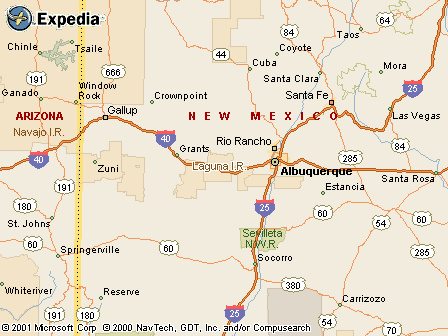|
|
Canku Ota |
|
|
(Many Paths) |
||
|
An Online Newsletter Celebrating Native America |
||
|
June 5, 2004 - Issue 114 |
||
|
|
||
|
Students Explore Mars |
||
|
by Philip Chien - Correspondent -Indian Country Today |
||
|
credits: Students Mark Vallejos and Brandon Herrera along with teacher Joe Aragon, pose with a model of the Mars Exploration Rover at NASA’s Jet Propulsion Laboratory. (Photo courtesy Joe Aragon) |
|
Geologist Larry Crumpler, a research curator at the New Mexico Museum of Natural History and Science wanted to get New Mexico students involved. Science and math teacher Joe Aragon at Laguna/Acoma High School sent the winning proposal for how the program would help their students. The Laguna/Acoma High School has approximately 400 students and 35 teachers. It’s a public school located on the Laguna pueblo reservation in a rural area. The student body is about 80 percent American Indian and 20 percent Hispanic. Aragon selected students who had shown initiative in the past and would be active participants. Spirit and Opportunity landed on Mars Jan. 3 and 24. Each intern group got to visit NASA’s Jet Propulsion Laboratory (JPL) for a week and help the scientists. The Laguna/Acoma students were fortunate enough to visit during one of the most exciting periods of the mission - while preparing for the landing of the second spacecraft on Mars the first spacecraft wouldn’t respond to commands from Earth. Aragon and students Mark Vallejos, 18, and Brandon Herrera, 16, arrived at JPL on Jan. 18, two weeks after Spirit’s landing. Their first night coincided with the Acoma Pueblo’s pilgrimage for the safety and welfare of the tribe and the world. Aragon noted, "Because of cultural religious activities at home, it was especially important for me to stay awake and active [that] night. This all-night observance was for the support of the individuals involved in a religious pilgrimage back home, so it made it doubly significant for me this first night ‘on Mars.’" Aragon and his students attended meetings with the scientists. The meetings discussed the progress as well as which rock was most interesting to look at next and which science instruments should be used. The interns were put to work, measuring the sizes of tiny pebbles and rocks in the photos. The Mars scientists have a simple method of keeping track of what’s what on Mars - nicknames. During the 1996 Mars Pathfinder mission one rock looked like Yogi Bear, so it got nicknamed "Yogi." That earned the team a personal cartoon from Yogi’s creator Bill Hanna. One football-size rock stood out. Principal scientist Steve Squires said that the preliminary name "pyramid" was too boring so they’d have to find a more distinguished name. The team chose Adirondack, after the Adirondack mountain range in New York. In the official release NASA noted "The word Adirondack is Native American and is interpreted by some to mean ‘They of the great rocks.’" Engineers sent Spirit the commands to drive up to Adirondack and put its arm against the rock. The arm includes a drill to cut away the surface and peer into the rock, a microscope camera, and a chemical analyzer. But just as Spirit reached Adirondack on Jan. 21 it stopped communicating with Earth. While some engineers tried to determine what went wrong with Spirit the rest of the team prepared for Opportunity’s landing on Mars. After the incredibly successful Spirit landing several weeks earlier, but mysterious communications problems, everyone was anxious. The Laguna/Acoma team was scheduled to go home on Jan. 24. But that night the second spacecraft, Opportunity was going to land. It was a chance they didn’t want to pass up. "We had to give up our apartment because the next team was supposed to take over," Aragon said. Even without a place to stay Aragon and the students decided it was worth it to hang around another day. They watched the Opportunity landing with the Spirit scientists, away from the bedlam in the mission control room where anxious engineers monitored the landing, with high level NASA officials and VIPs looking over their shoulders. "As it got closer to the landing we saw a flurry of activities in the science building and it was really exciting. It was a pretty anxious time for everybody we noticed there. When it landed I even felt relieved, I was nervous," Aragon said. |
|
|
www.expedia.com |
|
|
||
|
|
||
| Canku Ota is a free Newsletter celebrating Native America, its traditions and accomplishments . We do not provide subscriber or visitor names to anyone. Some articles presented in Canku Ota may contain copyright material. We have received appropriate permissions for republishing any articles. Material appearing here is distributed without profit or monetary gain to those who have expressed an interest. This is in accordance with Title 17 U.S.C. Section 107. | ||
|
Canku Ota is a copyright © 2000, 2001, 2002, 2003, 2004 of Vicki Barry and Paul Barry. |
||
 |
 |
|
|
The "Canku Ota - A Newsletter Celebrating Native America" web site and its design is the |
||
|
Copyright © 1999, 2000, 2001, 2002, 2003, 2004 of Paul C. Barry. |
||
|
All Rights Reserved. |
||
 COCOA
BEACH, Fla. - A team of students at Laguna/Acoma High School in
New Mexico is helping NASA explore Mars. They’re one of only
13 student groups selected by Cornell University as student interns
for the Mars Exploration Rovers.
COCOA
BEACH, Fla. - A team of students at Laguna/Acoma High School in
New Mexico is helping NASA explore Mars. They’re one of only
13 student groups selected by Cornell University as student interns
for the Mars Exploration Rovers.